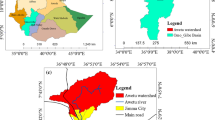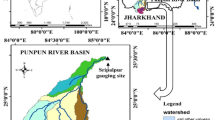Abstract
In this study, hydrologic regimes of the Palas basin have been investigated with land use/land cover (LULC) change. To investigate the relationship between precipitation and surface runoff, a SWAT (Soil and Water Assessment Tool) model was developed and runoff response was analysed under different LULC conditions. Firstly, Post classification change detection technique was used to prepare time series LULC maps of the years 1987, 2000 and 2011. The overall classification accuracy of 86% and Kappa Coefficient (K) of 0.82 were achieved. Then model was manually calibrated using monthly historical streamflow records. The calibration was successful with coefficient of determination (R 2) value of 0.61 and the Nash and Sutcliffe efficiency value of 0.55. Validation of the calibrated model using independent dataset shows even better model performance with Nash and Sutcliffe efficiency value of 0.62 and R 2 value of 0.85. The results of this research study are as follows. Agriculture area in Palas Basin considerably expanded (47%) in the last 24 years. Consequently, the area of bare soil declined (36%) markedly during the period 1987–2011. Simulations of runoff for the 2000–2011 period with the SWAT model showed that, under the LULC conditions of 1987, surface runoff would be 40% lower compared to runoff under the LULC conditions of 2011. For the development of sustainable water resource strategies, it is essential to establish interaction between land use changes and local hydrology. Although more observed data is needed for model accuracy, SWAT can provide useful data for water sources planners and policy makers.





Similar content being viewed by others
REFERENCES
Arnold, J.G., Srinivasan, R., Muttiah, R.S., and Williams, J.R., Large area hydrologic modeling and assessment—part 1: model development, J. Am. Water Resour. Assoc., 1998, vol. 34, pp. 73–89.
Azgin, S.T. and Dadaser-Celik, F., Spatial and temporal changes at Tuzla (Palas) Lake in Turkey, J. Water Clim. Change, 2015, vol. 6, no. 4, pp. 787–799.
Behera, S. and Panda, R.K., Evaluation of management alternatives for an agricultural watershed in a sub-humid subtropical region using a physical process-based model, Agric. Ecosyst. Environ., 2006, vol. 113, nos. 1–4, pp. 62–72.
Bieger, K., Hörmann, G., and Fohrer, N., The impact of land use change in the Xiangxi catchment (China) on water balance and sediment transport, Reg. Environ. Change., 2013, vol. 15, no. 3, pp. 485–498.
Bolstad, P.V. and Lillesand, T.D., Rapid maximum likelihood classification, Photogramm. Eng. Remote. Sens., 1991, vol. 57, pp. 67–74.
Calder, I.R., Reid, I., Nisbet, T.R., and Green, J., Impact of lowland forests in England on water resources: application of the hydrological land use change (HYLUC) model, Water Resour. Res, 2003, vol. 39, no. 11, p. 1319.
Congalton, R. and Green, K., Assessing the Accuracy of Remotely Sensed Data: Principles and Practices, Taylor & Francis Group, 1999, 2nd edition.
Githui, F., Mutua, F., and Bauwens, W., Estimating the impacts of land-cover change on runoff using the soil and water assessment tool (SWAT): case study of Nzoia catchment, Kenya, Hydrol. Sci. J., 2009, vol. 54, no. 5, pp. 899–908.
Inzana, J., Kusky, T., Higgs, G., and Tucker, R., Supervised classifications of Landsat TM band ratio images and Landsat TM band ratio image with radar for geological interpretations of central Madagascar, J. Afr. Earth Sci, 2003, vol. 37, nos, 1–2, pp. 59–72.
Jensen, J.R. and Cowen, D.C., Remote sensing of urban suburban infrastructure and socio-economic attributes Photogramm, Photogramm. Eng. Remote. Sens., 1999, vol. 65, no. 5, pp. 611–622.
Moriasi, D.N., Arnold, J.G., Van Liew, M.W., Bingner, R.L., Harmel, R.D., and Veith, T.L., Model evaluation guidelines for systematic quantification of accuracy in watershed simulations, Trans. ASABE, 2007, vol. 50, no. 3, pp. 885–900.
Moroglu, M. and Yazgan, S., Implementation of EU water framework directive in Turkey, Desalination, 2008, vol. 226, nos. 1–3, pp. 271–278.
Ottinger, M., Kuenzer, C., Liu, G., Wang, S., and Dech, S., Monitoring land cover dynamics in the Yellow River Delta from 1995 to 2010 based on Landsat 5 TM, Appl. Geogr., 2013, vol. 44, pp. 53–68.
Özlü, T. and Gündüz, S., Hydrographic features of the Tuzla Lake (Kayseri) and level changes occurred between the years 1975–2015, First. Uni. J. Soc. Sc., 2017, vol. 23, pp. 1–14.
Sajikumar, N. and Remya, R.S., Impact of land cover and land use change on runoff characteristics, J. Environ. Manage, 2015, vol. 161, pp. 460–468.
Santhi, C., Arnold, J.G., Williams, J.R., Dugas, W.A., Srinivasan, R., and Hauck, L.M., Validation of the SWAT model on a Large River Basin with point and nonpoint sources-1, J. Am. Water Resour. Assoc., 2001, vol. 37, no. 5, pp. 1169–1188.
Santra, P. and Das, B.S., Modeling runoff from an agricultural watershed of western catchment of Chilika lake through ArcSWAT, J. Hydro-Environ. Res., 2013, vol. 7, no. 4, pp. 261–269.
Sivakumar, M.V.K., Das, H.P., and Brunini, O., Impacts of present and future climate variability and change on agriculture and forestry in the arid and semi-arid tropics, Clim. Change, 2005, vol. 70, no. 1, pp. 31–72.
Tamas, J., Nagy, A., and Feher, J., Agricultural biomass monitoring on watersheds based on remotely sensed data, Water Sci. Technol., 2015, vol. 72, no. 12, pp. 2212–2220.
Vandenberghe, V., Griensven, A., and Bauwens, W., Sensitivity analysis and calibration of the parameters of ESWAT: application to the River Dender, Water Sci. Technol., 2001, vol. 43, no. 7, pp. 295–301.
Zuo, D., Xu, Z., Yao, W., Jin, S., Xiao, P., and Ran, D., Assessing the effects of changes in land use and climate on runoff and sediment yields from a watershed in the Loess Plateau of China, Sci. Total Environ., 2016, vol. 544, pp. 238–250.
Author information
Authors and Affiliations
Corresponding authors
Rights and permissions
About this article
Cite this article
Sukru Taner Azgin, Filiz Dadaser Celik Evaluating Surface Runoff Responses to Land Use Changes in a Data Scarce Basin: a Case Study in Palas Basin, Turkey. Water Resour 47, 828–834 (2020). https://doi.org/10.1134/S0097807820050206
Received:
Revised:
Accepted:
Published:
Issue Date:
DOI: https://doi.org/10.1134/S0097807820050206




